NEWS: S&P downgrade of QVC Credit Rating
QVC received its fourth ratings downgrade of 2025 with the new one coming from S&P. S&P has now taken them from CCC+ to CCC.
S&P expects a 50-70% recovery on QVC, Inc senior secured notes (rounded to 55%) and expects a 0-10% (rounded 0%) on the unsecured debt. Senior secured notes went from B- to CCC+ and LITNA unsecured went from CCC- to CC. This would leave nothing for QVCGA, QVCGB, or QVCGP.
S&P called out exactly what I did a few months ago that the revolver refinance will likely not be on favorable terms.
Sean's Analysis:
I continue to see some debt exchange as unlikely, I engaged with TJ directly on his Substack and felt his rebuttal wasn't worth me engaging back with. And his post yesterday goes to taxes which is where he is strong, but not how these situations unfold so his understanding is naturally flawed by his experience bias (i.e., taxes). The risk is heavily tilted towards chapter 11 prepack or freefall and not an out-of-court liability exchange.
As I wrote before, a likely assumption why QVC was even able to draw the $975M was with a prepetition agreement with the banking syndicate to turn the debt into a DIP in postpetition which would then subordinate the senior secured notes by making them senior unsecured, otherwise if the company files banks + senior secured are all in the same class and fighting. TJ continues to frame things with " there is one basic reason why the banks will not allow the bondholders to take over QVC, Inc." but it is the company's choice to file in this situation and banks are equal to bonds in recovery in the current state of things.
Even if some friendly out-of-court exchange took place I just can't see the costs working. To make an LME work they would have to offer the bondholders a decent carrot - TJ keeps referencing WBD but the situation isn't close to the same with QVC. WBD was splitting into two "stronger" companies and the bonds were unsecured and they had the ability to be subordinated but regardless got a decent pay given where they traded. QVC, Inc bonds are senior secured against the QVC, Inc equity so they can't be subordinated even with a 75% vote as you would need 100% to remove the sacred rights of EACH TRANCHE. You may get some covenant protections stripped if a vote occurred but the collateral is the collateral and seniority is the seniority. Again, even if it worked as TJ writes, you would need majority in each group to vote and approve - unlikely. 2027-2028 exchange for the 2029 notes saw holdouts so to assume we get nothing here doesn't make sense.
TJ keeps lumping these folks into one bond holder group too, but this isn't bankruptcy (yet) so they're all separate players. He stated to me " you may be right that retiring all bonds with $1 billion may be a stretch. But there’s plenty of precedent for tender offers that aren’t 100%. Your math assumes 100% only. At 50% tender+consent, tons of rights are stripped with liquidity to spare. At 75%, the bonds can be subordinated". These bonds will not be subordinated so if this is his angle to see the LME work he will not see it.
I shared this analysis before on what I thought a friendly carrot for bonds may look like in an LME:
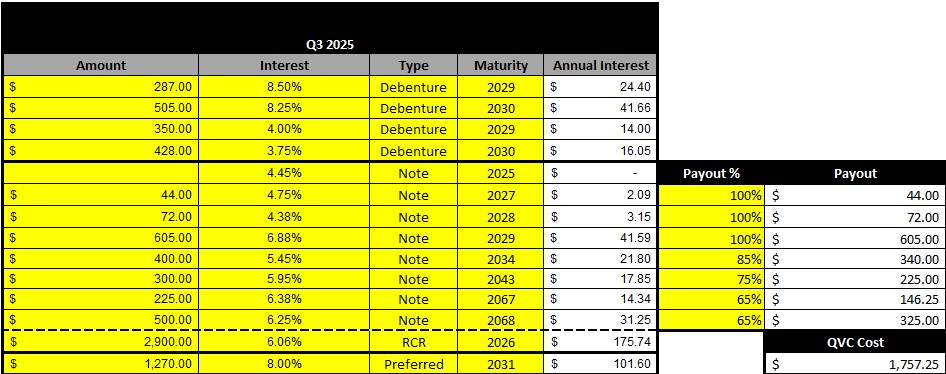
Here this is too aggressive as QVC, Inc only has $1,305M in capital to play and this move would require $1,757.25M, so rest of the cash would need to be down streamed BUT it also leaves no room for working capital and various other spends needed to run/fund the business. It also uses up almost all the QVC Group total cash so also makes it unlikely.
I presented to TJ another side which assume the following exchange:
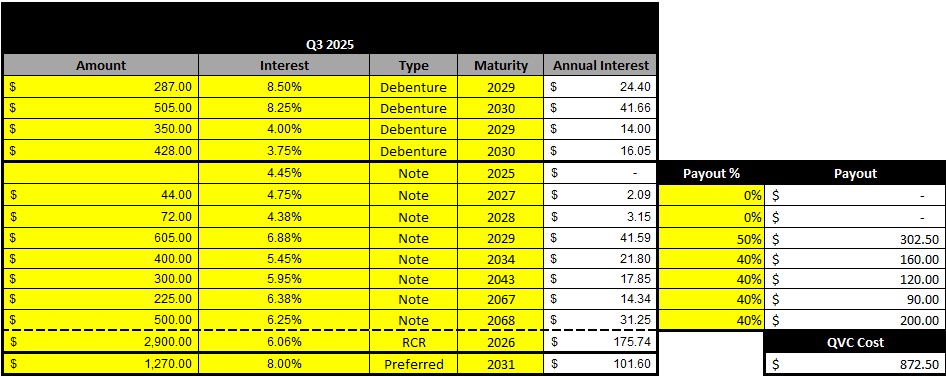
This move would cost QVC, Inc $872.50M and leave them with $432.50M in liquid capital. Now the question is do bond holders bite on this out-of-court LME given the payouts are this low? Unlikely. He assumes holders are distressed themselves and "hate their paper" but in the game of distressed debt many have been buying on the secondary market(s) and likely are not as bad off as he believes. So taking steep haircuts here will likely not make sense for how these folks play.
Many funds have limits and once a bond hits that price limit they become forced sellers and selling begets more selling as they say. Dr. Burry was once a proponent of this exact statement. Even if a fund believed in QVC, because of the price trigger they would be forced to sell. Those that can keep holding have marked-to-market likely as I wrote before and these become tax loss assets once the loss is crystalized, or in the event the company does restructure then any gain is positive as it's going from a book loss to a real gain for these funds once they exit - reason to holdout.
Now this $872.50M is also without any consent fees, transaction costs, or tax impacts. This then makes even the $872.50M exchange less likely as QVC would have to offer less carrot to bondholders. If the company is going in with less this then means the bonds are less likely to engage and bite.
TJ wrote to me " your math assumes 100% only. At 50% tender+consent, tons of rights are stripped with liquidity to spare. At 75%, the bonds can be subordinated." and I challenge my math assumes EACH TRANCHE is not voting to strip their rights to then take pennies on the dollar. And reality is there is no effective LME without 100% removal of the senior secured notes anyway. If they still have half, then how was the LME a success?
In total QVC, Inc interest is ~$307.8M annually with the additional $975M drawn bringing the credit facility to $2,900M. If they take out all senior notes ($2,146M for annual interest of $132.08M) this drops annual interest to $175.74M ($2,900M @ 6.06%). Problem we have is the banks now bare all the risk and the near maturity and if EBITDA is on decline they will 98% push for an amendment and a new rate will go into play. This is how banks work and I will disagree with TJ that even with a loose credit agreement there is no way banks are not getting a higher rate. I modeled the 9.055% off current SOFR rate, margin penalty, + credit spread on B/CCC debt.
Below are the annual interest savings with all senior notes gone and depending on where revolver rate may go:
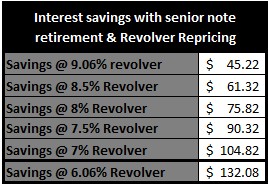
With $2,900M drawn, if credit facility rate stays at 6.06% the savings annually is $132.08M but if it goes to 8.5% it's only $61.32M and at 9.06% (really 9.055%) then interest savings is only $45.22M. Now one could argue QVC will issue new paper and pay the facility down and term the debt, but then I challenge what was the point? $1,025M was already termed 2043-2068 and they won't get that debt termed with new paper for lower than 9% either and the current average rate is 6.19% so paying the revolver down with new paper could just leave them with an even higher interest than 9.06%. From here the interest savings isn't very attractive and despite what TJ says, you need 100% buy-in to get a successful LME IMO.
TJ also stated to me "and if you assume they still don't have enough cash, that's not true. They have more liquidity than $1 billion. The Credit Agreement allows for essentially unlimited incremental borrowing above the $3.25B capacity" but this is not free cash even if the banks agreed to give them more. Every draw comes with a current 6.06% hit until they pay it back and ultimately just pulls maturities forward by using bank capital to buy long-dated debt. I won't entertain the fact the banks would have to agree to give QVC more money too, but regardless if they take more money than you can 100% expect a higher interest rate in a refinanced credit facility. So every dollar borrowed to take on the LME is not free. And with EBITDA where it is, what bank is allowing this? It violates their nature.
Also is there just no modeling on what this does? If banks were to violate their very nature and say "here QVC, borrow another $250M" where does this leave QVC? Does this very notion not invalidate the ENTIRE reasoning for the LME? $2,900M drawn and TJ says they can borrow more....fine. Let's say it's $250M then we have $3,150M drawn and even with no other senior debt the leverage ratio is 3.5x at $900M EBITDA so guess what, even after LME they're restricted in new debt and upstreaming. If EBITDA falls to $800M then leverage ratio is 3.94x. If new revolver rate goes to 9.055% (again modeled off SOFR, margin, current B spread) then this itself only saves QVC $22.59M in annual interest. Wasted effort it seems.
There's also no valuation attempt by these guys either which makes this harder to buy-in to their attempts at legal loopholes and whatever else will salvage QVCGA positions. Let's go with a multiple of 4.5x which is fair for where distressed companies are usually at. Let's model 2027-2028 are taken out at 80% cost, 2029 at 50%, and 2034-2068 at 40% which leaves QVC, Inc with $339.70M in cash (not accounting for transaction & consent either). We have $2,900M credit facility, $92M minority interest, $1,570M LITNA unsecured debentures, value the DTL at $565M. Then we only return to positive equity value at $1,000M EBITDA and even then it likely doesn't make many holders whole since it's still below $1.00 in pre-split terms:
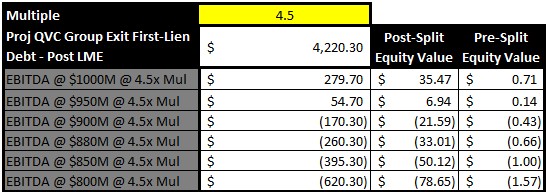
I did $565M for the DTL based on the company's statement of "Disallowed interest in current and future years results in significant deferred interest carryforward by 2030 which should offset almost half of gross DTL at maturity".
At a 5x multiple then equity value starts to breathe again, but the crux of the entire issue is the business being in secular decline and an LME doesn't solve that:
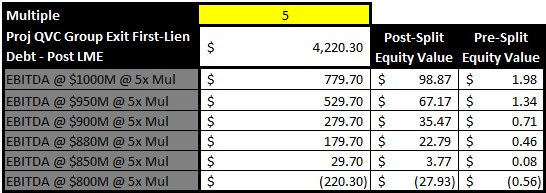
If EBITDA drops to $800M which is FITCH low-end then we still have negative equity value. What about $750M? $700M?
If the company files chapter 11 there become some options that make the "new" QVC viable even in secular decline. Many ways to model this though and no telling where courts, lawyers, and company will land until things get into motion.
Banks have $2,900M drawn on their dime and may work with the company to convert some of this prepetition debt into postpeition DIP giving them super priority and remove some of the struggle of their money and bond money being pari passu. QVC, Inc has $1,305M of a war chest heading into this but depending on how long this drags it's not too deep a war chest and even losing 20% due to legal fees and whatever else really only gives them $1,044M to leverage by EOY.
Let's use the $1,305M though and assume QVC, Inc uses $700M to pay banks down. This now leaves $2,200M left on the banks dime and QVC has ~$605M to use which is important. Given EBITDA declines it's possible the banks cannot be made whole so I could see $1,000M being converted to new equity (45.5% of outstanding $2,200M revolver) which leaves $1,200M (54.5%) of bank debt that can convert to new paper in a reorg. The rest of the senior secured notes receive no cash and only equity in the "new" QVC.
Using a plug of 20% costs for bankruptcy and then another 35% for MIP, rights/backstops, and GUC here is where QVC, Inc value could be with a 4.5x multiple and a range of EBITDA:
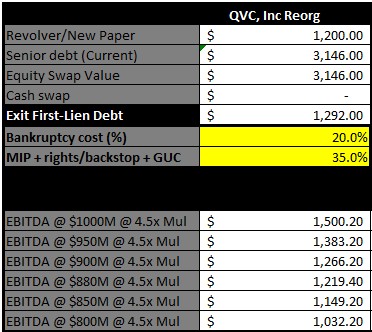
The important note here is QVC, Inc upstreams a dividend to parent and last year it was $108M which now stays home. Interest expense will be saved so that also flows into cash. There will be some tax adjustments as TJ writes, but the cash generation is key. It's possible new owners can install a new boards, new management, and be focused on growing the business.
Coming of of bankruptcy leaner than with an LME it's also possible a 6x multiple gets assigned and then that also changes equity value:
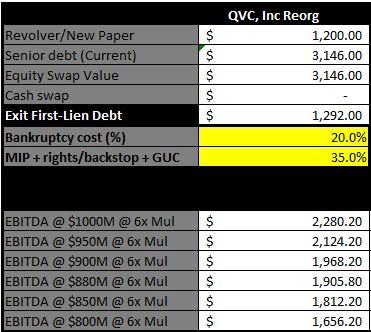
The questions then become does the new QVC, Inc become a public entity, does it stay private and then is eventually sold? So a few "what-ifs" here but I show the above as there is a few ways for creditors to look at this and feel they make out better even in a decline.
We will see where this goes, but I do not see a path for QVCGA to make money. The risks are significant and many are down 80-95% on their position waiting for corporate unicorns to appear. I hope it works, but I am not seeing a path to where it does. History of these situations does not support the narrative portion of this either for QVCGA.
Greg Maffei may be able to engineer something I am told. As TJ wrote to me "there’s precedent. There are many levers to pull out of court. To me, BK looks lazy, and Greg Maffei isn't lazy. " but then I challenge if Greg was able to do so much, why not do it sooner? Why let the business get here? If the ship is so easy to steer why not turn it years ago? I suppose my learning from Dr. Burry leaves me not wanting to hope for these situations. When you're wrong, admit it fast, and find another way to play. For me there is still a way to play QVC, but it is not in QVCGA.
On TJ's recent post I see comments between him and another poster debating if the new management RSU cancellation is a *necessary* condition for bankruptcy. I don't think myself or anyone have argued it is. They are arguing is a symptom necessary for the disease? It's a symptom of bankruptcy, not a cause by any means. Bankruptcy can present with or without the RSU/cash policies, but it usually does present with it. This is a standard KERP/KEIP program.
I think though analyzing one symptom isn't what's needed for this patient. Let's look at a few of them together and what do we see?
- March 7th, 2025: Fitch downgrades QVC to B- from B
- May 23rd, 2025: QVC Group suspended paying QVCGP dividend.
- May 27th, 2025: QVC hired Evercore, Inc and Kirkland & Ellis and senior holders hired PJT Partners and David Polk & Wardell
- LITNA holders hired Centerview and Akin Gump Strauss Hauer & Feld
- May 30th, 2025: Fitch downgraded QVC again going from B- to CCC+.
- June 20th, 2025: QVC hired Roger Meltzer of DLA Piper and Carol Flaton to the board paying each $50K a month.
- August 7th, 2025: Earnings released and revenue further dissapointed. Revolver had $75M drawn in addition. It was also reported after earnings period company borrowed another $975M on the revolver bringing total borrowings to $2,900M.
- August 13th, 2025: QVC credit syndicate got 75% together and hired Simpson Thacher & Bartlett.
- August 15th, 2025: Company adjusted executive compensation which mirrors a KERP/KEIP plan.
- August 26th, 2025: S&P downgraded QVC from CCC+ to CCC.
Happy & cautious investing,
Sean |











